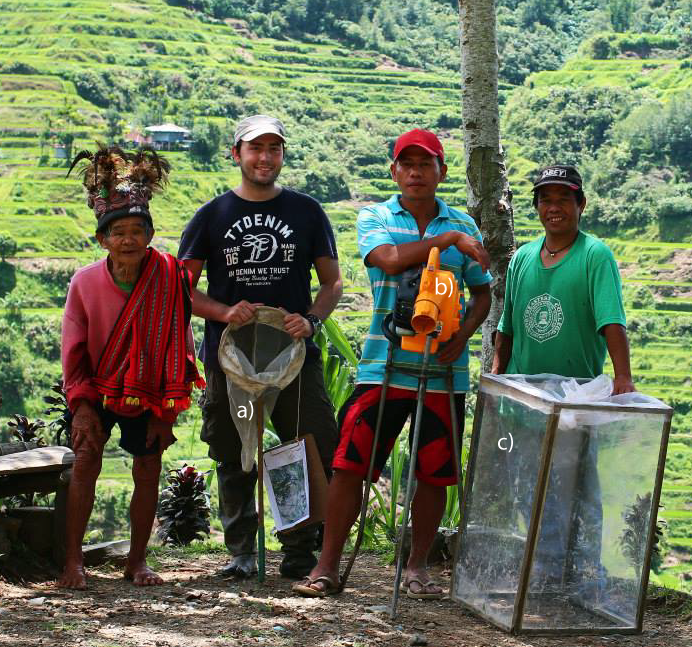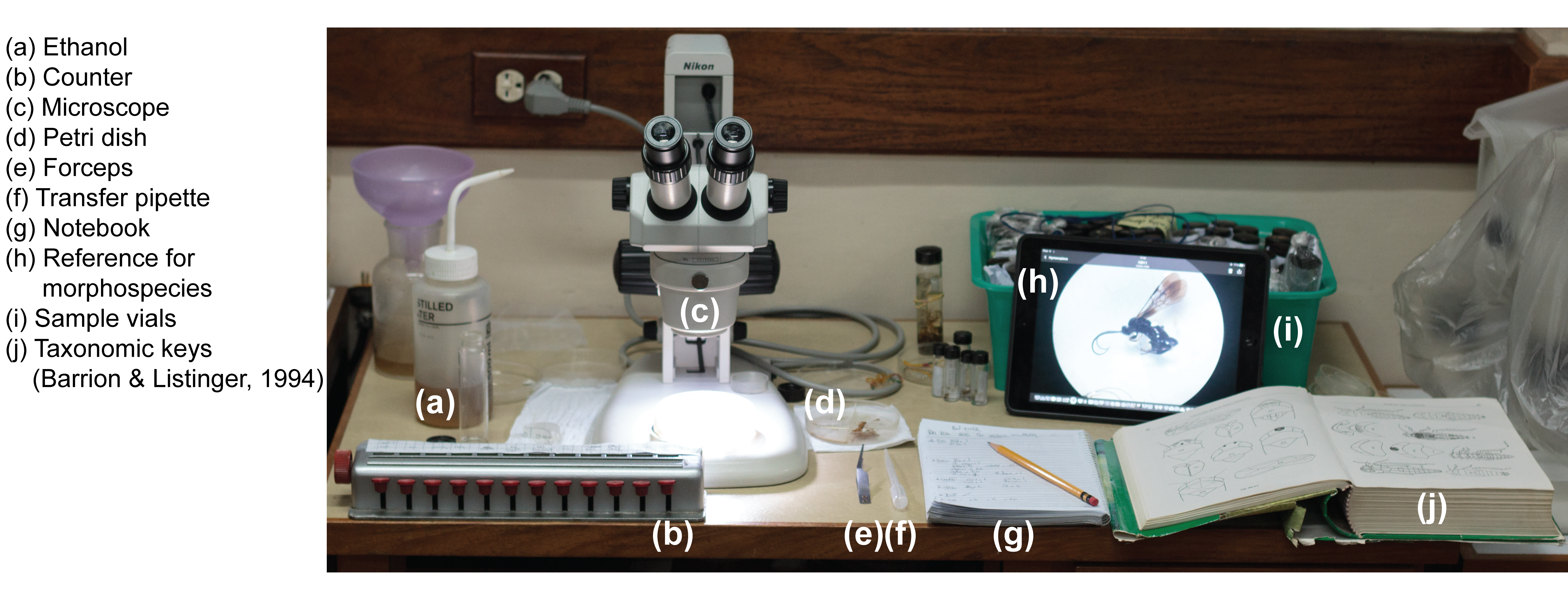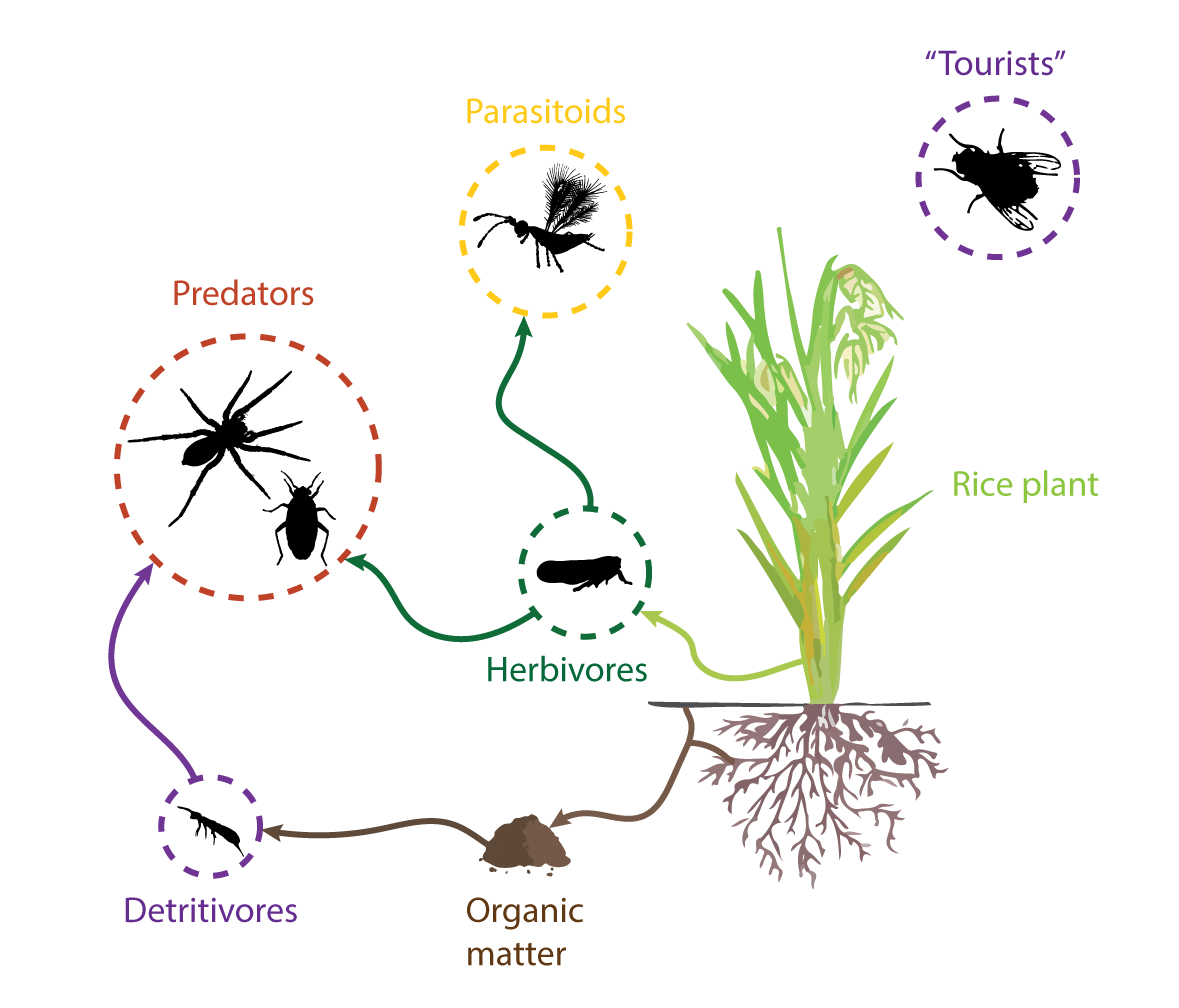My PhD research objectives and main findings
Fieldwork in the rice fields and measuring landscape heterogeneity
 Rice terraces surrounding Batad
Rice terraces surrounding Batad
Being a PhD student at the Helmholtz Centre for Environmental Research (UFZ) was the best opportunity since it was the perfect combination of my developed interests for landscape ecology, biological control and tropical ecosystems. Moreover, to my knowledge, no one had yet investigated the effects of landscape heterogeneity on arthropods in rice agro-ecosystems. Consequently, being part of this project felt like I would venture into the unknown. The study itself required a considerable amount of time in the Philippines to collect the data and identify the arthropods. Therefore, I spent more than 13 months as a guest scientist at the International Rice Research Institute in Los Baños to conduct my fieldwork, while immersing myself in a new culture. The Philippines is a unique and wonderful country where people showed me constant kindness and respect. Someone once said that first impressions are lasting ones. My first introduction to the Philippines started with a visit of the “eighth wonder of the world”, the rice terraces of Batad. These hand-carved rice terraces are a remarkable example of a cultural landscape that is believed to be 2,000 years old. However, rice production is facing multiple challenges and rice terraces are being abandoned by the younger generations for more attractive jobs in the cities.
The experience of living in a foreign country and culture can turn into the best stories, i.e. the simple discovery of a large Atlas beetle (Chalocosoma atlas), or witnessing the power of the typhoons Yolanda and Rammasun (and consequently living without electricity for two weeks), or just becoming unexpectedly addicted to video-karaoke. During my PhD, I studied the effect of landscape heterogeneity on the biological control function in rice agro-ecosystems in the Philippines. The aim was to disentangle the effects of landscape composition and configuration on rice-arthropod communities at the landscape level. Therefore, I tried to answer the following questions:
- What is the effect of fine-scale landscape heterogeneity and regional-scale drivers on rice arthropods? Is a binary description of the landscape heterogeneity adequate to identify responses from the rice-arthropod community?
- How does the composition and configuration of the landscape affect the abundance and species richness of rice-arthropods? Are trophic interactions more important than the effects of landscape heterogeneity on the distribution of rice-arthropods?
- How does landscape heterogeneity influence species traits of arthropods in rice agro-ecosystems?
Sampling arthropods in rice fields
I sampled the arthropods using two sampling methods: a sweep net method and a vacuum (blow-vac) method. In irrigated rice fields, the composition of the terrestrial arthropod community changes with the development of the rice crop and between cropping seasons. Farmers in the Philippines usually produce two rice crops per year in the lowlands - one during the dry season (January to June) and one during the wet season (June to December) - but only one in the highlands (January-June). The arthropods were sampled when the rice plant was at the maximum tillering stage (50 days after transplanting) because this stage is generally associated with a maximum abundance of arthropods.

The sweep net is a simple and inexpensive way to monitor the presence of a variety of arthropods. The blow-vac machine was operated by a gasoline-powered motor and may be used for more quantitative studies of arthropods in rice. I used a custom-built sampling enclosure of about 1 m side length that was placed over four rice hills to prevent any escape of mobile invertebrates.
Identification of arthropods
Once sampled, invertebrates were preserved in 70% ethanol. Most insects were sorted, counted, and identified using a binocular microscope to species level (or morphospecies level when species level was not possible); however, dipterans (flies) and collembolans (small detritivores), as well as arachnids (spiders) were only identified to family level due to the morphological similarity at the preadult stages and the quality of samples.

In addition, the arthropods were grouped into functional groups as follows: detritivores/tourists, predators, parasitoids and herbivores.

Measuring landscape heterogeneity
Using Geographic Information Systems (GIS), I described the two main components of landscape heterogeneity: compositional and configurational heterogeneity. First, I identified and mapped the landscape features around each sampling site using heads-up digitizing in a geographic information system (ArcGIS 10.3, ESRI) based on high resolution SPOT-5 DIMAP images (2.5 m). In addition, I collected ground-truth data to verify the photointerpretation using Collector for ArcGIS (version 9.3, ESRI). I randomly attributed 10 ground-truth locations, verified the land cover in the field and if necessary corrected the digitized maps. Landscape features were classified into eight final categories: rice bunds, rice fields, plantations, artificial areas, bare soil/grasslands, woodlands, hydrographic network and ponds. Finally, landscape metrics were calculated at different levels to describe single landscape elements such as the size or shape of patches, or for whole landscapes by describing the arrangement of patches and composition of the landscape.

Main findings
The availability of non-crop habitats at the ecotone of the rice habitat and the spatial arrangement of the rice habitat can benefit natural enemies and reduce pest densities. The rice bunds provide an interesting prospect for ecological engineering applications as they can facilitate the movement of natural enemies and offer them additional shelter and resources.
In addition, the spatial and temporal heterogeneity of the rice habitat may benefit generalist predators via landscape supplementation. The methods that have been used in this thesis have showed the importance of adopting modern tools to quantify the landscape heterogeneity of rice agroecosystems.
Finally, the results of my thesis act as a pioneer for further landscape ecology approaches in rice agro-ecosystems, and its findings provide useful information for the enhancement of natural biological control at the landscape level.
More information
Please see below for publications or talks related to my PhD work.